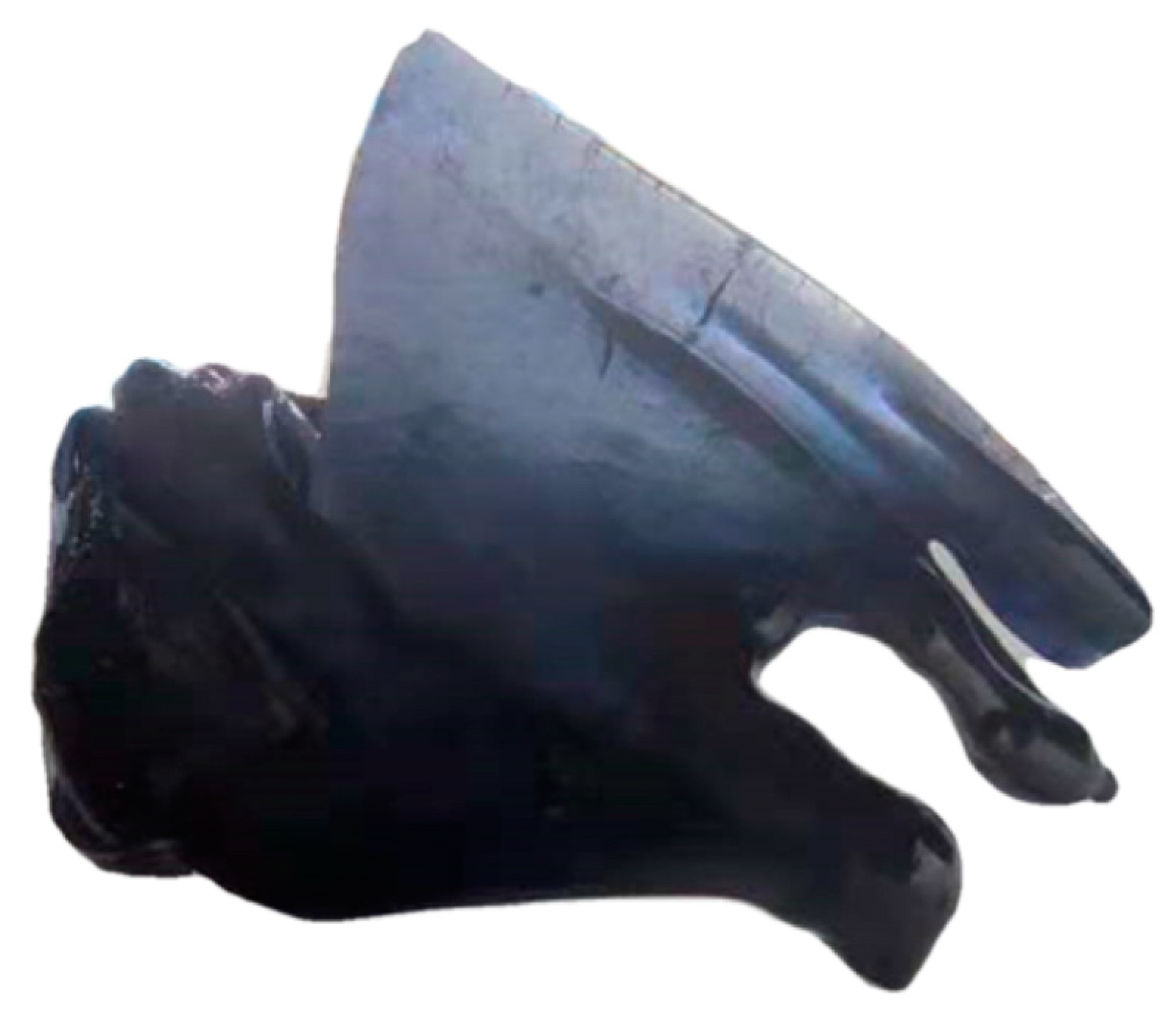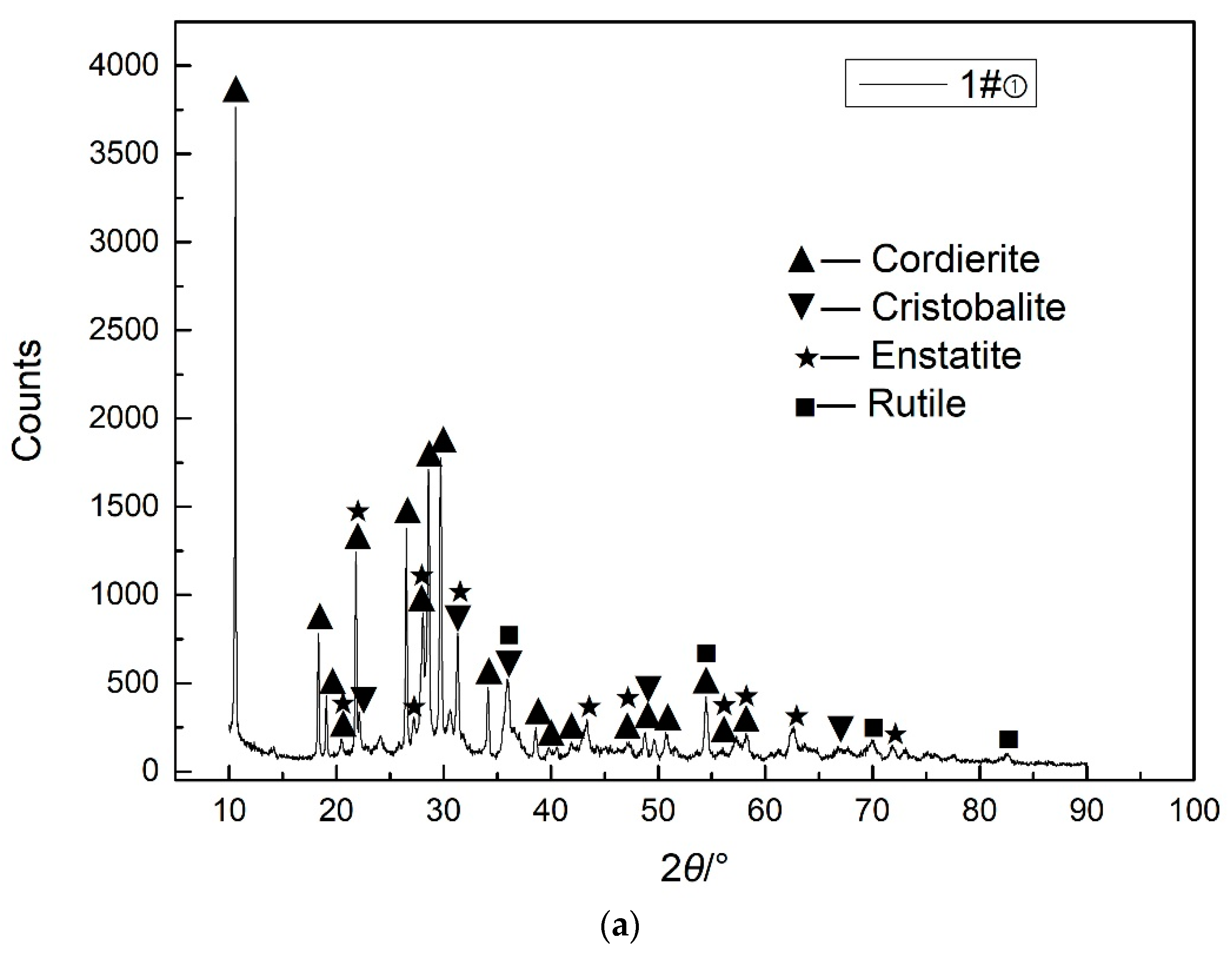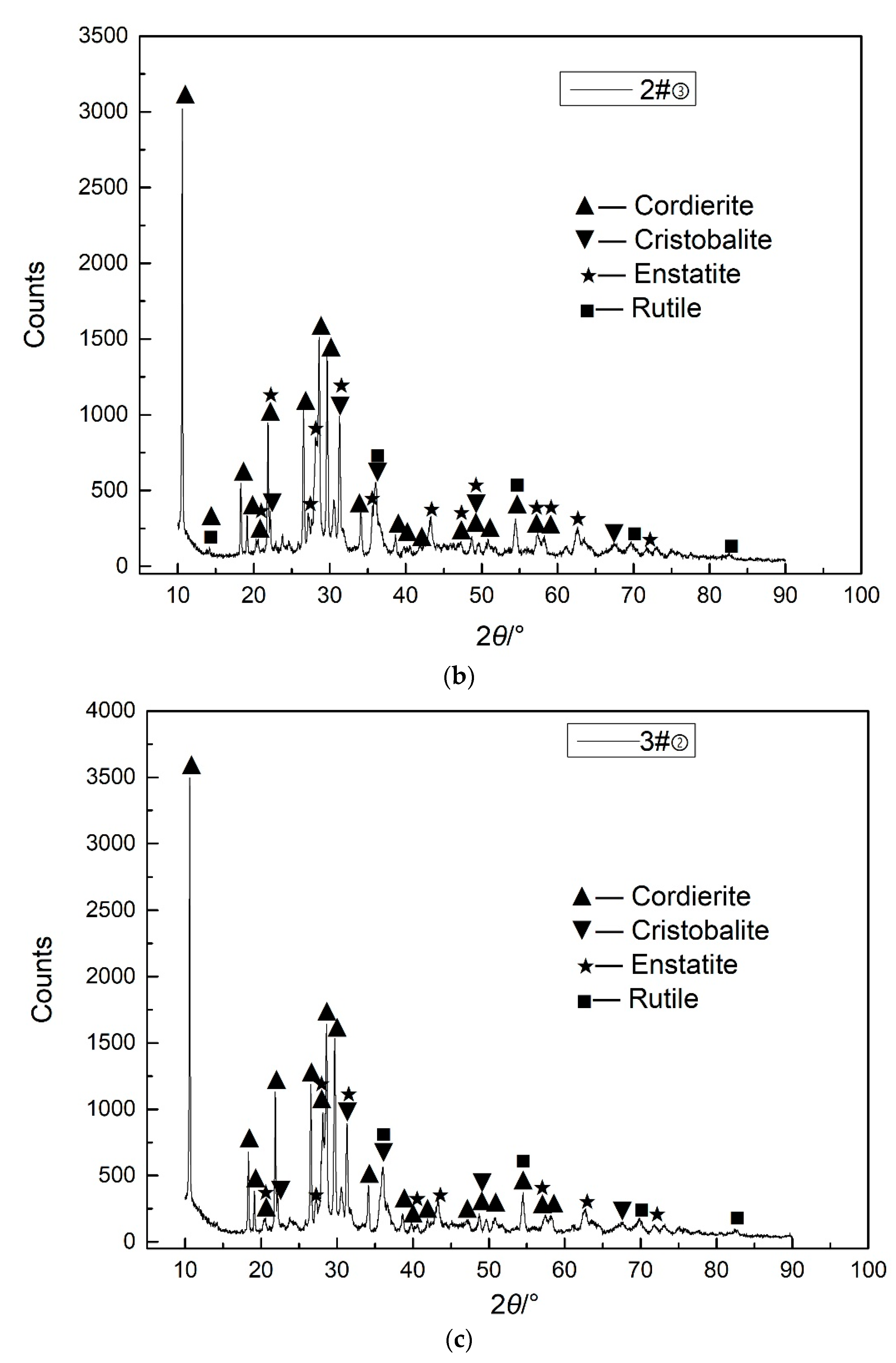Properties of Glass-Ceramics Prepared from Industrial Multi-Wastes
Abstract
:1. Introduction
2. Experimental Scheme
2.1. Experimental Materials
2.2. Experimental Methods
3. Experimental Results and Discussion
3.1. X-ray Diffraction (XRD) Analysis
- (1)
- Orthogonal test table L9 (33)
| Numbering | Factor 1 (Basic Glass Powder Mass/g) | Factor 2 (Molding Pressure/MPa) | Factor 3 (Holding Time/min) |
|---|---|---|---|
| 1 | 1 (4) | 1 (30) | 1 (8) |
| 2 | 1 | 2 (35) | 3 (12) |
| 3 | 1 | 3 (40) | 2 (10) |
| 4 | 2 (6) | 1 | 3 |
| 5 | 2 | 2 | 2 |
| 6 | 2 | 3 | 1 |
| 7 | 3 (8) | 1 | 2 |
| 8 | 3 | 2 | 1 |
| 9 | 3 | 3 | 3 |
- (2)
- Adding experimental data
| Factor 1 (Basic Glass Powder Mass/g) | Factor 2 (Molding Pressure/MPa) | Factor 3 (Holding Time/min) | Crystallinity (%) | Crystallite Size (nm) |
|---|---|---|---|---|
| 4 | 30 | 8 | 38.2 | 46.71 |
| 4 | 35 | 12 | 38.5 | 43.37 |
| 4 | 40 | 10 | 38.7 | 46.07 |
| 6 | 30 | 12 | 38.1 | 48.59 |
| 6 | 35 | 10 | 41.1 | 52.23 |
| 6 | 40 | 8 | 36.8 | 51.05 |
| 8 | 30 | 10 | 33.7 | 64.27 |
| 8 | 35 | 8 | 36.4 | 50.46 |
| 8 | 40 | 12 | 34.8 | 49.88 |
- (3)
- SPSSAU platform for range analysis
| Items | Levels | Factor 1 (Basic Glass Powder Mass/g) | Factor 2 (Molding Pressure/MPa) | Factor 3 (Holding Time/min) |
|---|---|---|---|---|
| K value | 1 | 115.40 | 110.00 | 111.40 |
| 2 | 116.00 | 116.00 | 113.50 | |
| 3 | 104.90 | 110.30 | 111.40 | |
| K average value | 1 | 38.47 | 36.67 | 37.13 |
| 2 | 38.67 | 38.67 | 37.83 | |
| 3 | 34.97 | 36.77 | 37.13 | |
| Optimal level | 2 | 2 | 2 | |
| R | 3.70 | 2.00 | 0.70 | |
| Level quantity | 3 | 3 | 3 | |
| Repeat number r per level | 3.0 | 3.0 | 3.0 | |
- (4)
- Figure of the mean value of each level of the factor (Figure 4)
3.2. Scanning Electron Microscopy (SEM) Analysis
3.3. Hardness
3.4. Other Properties
4. Conclusions
- (1)
- The prepared samples are cordierite-dominated glass-ceramics.
- (2)
- In combination with the optimal level of each factor, it can be seen that the mass of the basic glass powder of factor 1 is optimal at the second level, namely, 6 g, the molding pressure of factor 2 is optimal at the second level, namely, 35 MPa, and the holding time of factor 3 is optimal at the second level, namely, 10 min. The optimal combination is “basic glass powder mass 6 g, molding pressure 35 MPa, holding time 10 min”.
- (3)
- The prepared glass-ceramics have good acid and alkali resistance, the Vickers hardness is up to 866 HV, and the bulk density is up to 2.99 g/cm3, which is obtained at the crystallization temperature of 970 °C.
Author Contributions
Funding
Data Availability Statement
Conflicts of Interest
References
- Yang, S.; Wang, L. Measurement of froth zone and collection zone recoveries with various starch depressants in anionic flotation of hematite and quartz. Miner. Eng. 2019, 138, 31–42. [Google Scholar] [CrossRef]
- Fontes, W.C.; de Carvalho, J.M.F.; Andrade, L.C.; Segadães, A.M.; Peixoto, R.A. Assessment of the use potential of iron ore tailings in the manufacture of ceramic tiles: From tailings-dams to ‘‘brown porcelain”. Constr. Build. Mater. 2019, 206, 111–121. [Google Scholar] [CrossRef]
- Zhao, S.; Fan, J.; Sun, W. Utilization of iron ore tailings as fine aggregate in ultra-high performance concrete. Constr. Build. Mater. 2014, 50, 540–548. [Google Scholar] [CrossRef]
- Li, C.; Sun, H.; Bai, J.; Li, L. Innovative methodology for comprehensive utilization of iron ore tailings: Part 1. The recovery of iron from iron ore tailings using magnetic separation after magnetizing roasting. J. Hazard. Mater. 2010, 174, 71–77. [Google Scholar] [CrossRef] [PubMed]
- Taha, Y.; Benzaazoua, M.; Hakkou, R.; Mansori, M. Coal mine wastes recycling for coal recovery and eco-friendly bricks production. Miner. Eng. 2017, 107, 123–138. [Google Scholar] [CrossRef]
- Wang, C.L.; Ni, W.; Zhang, S.Q.; Wang, S.; Gai, G.S.; Wang, W.K. Preparation and properties of autoclaved aerated concrete using coal gangue and iron ore tailings. Constr. Build. Mater. 2016, 104, 109–115. [Google Scholar] [CrossRef]
- Zhang, S.; Xue, X.; Liu, X.; Duan, P.; Yang, H.; Jiang, T.; Wang, D.; Liu, R. Current situation and comprehensive utilization of iron ore tailing resources. J. Min. Sci. 2006, 42, 403–408. [Google Scholar] [CrossRef]
- Li, C.; Sun, H.; Yi, Z.; Li, L. Innovative methodology for comprehensive utilization of iron ore tailings: Part 2: The residues after iron recovery from iron ore tailings to prepare cementitious material. J. Hazard. Mater. 2010, 174, 78–83. [Google Scholar] [CrossRef] [PubMed]
- Bastos, L.A.D.C.; Silva, G.C.; Mendes, J.C.; Peixoto, R.A.F. Using iron ore tailings from tailing dams as road material. J. Mater. Civ. Eng. 2016, 28, 04016102. [Google Scholar] [CrossRef]
- Duan, P.; Yan, C.; Zhou, W.; Ren, D.J. Fresh properties, compressive strength and microstructure of fly ash geopolymer paste blended with iron ore tailing under thermal cycle. Constr. Build. Mater. 2016, 118, 76–88. [Google Scholar] [CrossRef]
- Galvão, J.L.B.; Andrade, H.D.; Brigolini, G.J.; Peixoto, R.A.F.; Mendes, J.C. Reuse of iron ore tailings from tailings dams as pigment for sustainable paints. J. Clean. Prod. 2018, 200, 412–422. [Google Scholar] [CrossRef]
- Weishi, L.; Guoyuan, L.; Ya, X.; Qifei, H. The properties and formation mechanisms of eco-friendly brick building materials fabricated from low-silicon iron ore tailings. J. Clean. Prod. 2018, 204, 685–692. [Google Scholar] [CrossRef]
- Li, D.; Song, X.; Gong, C.; Pan, Z. Research on cementitious behavior and mechanism of pozzolanic cement with coal gangue. Cem. Concr. Res. 2006, 36, 1752–1759. [Google Scholar] [CrossRef]
- Miao, X.X.; Zhang, J.X. Analysis of strata behavior in the process of coal mining by gangue backfilling. J. Min. Saf. Eng. 2007, 24, 379–382. [Google Scholar]
- Zhang, N.; Sun, H.; Liu, X.; Zhang, J. Early-age characteristics of red mud–coal gangue cementitious material. J. Hazard. Mater. 2009, 167, 927–932. [Google Scholar] [CrossRef]
- Yang, M.; Guo, Z.; Deng, Y.; Xing, X.; Qiu, K.; Long, J.; Li, J. Preparation of CaO–Al2O3–SiO2 glass ceramics from coal gangue. Int. J. Miner. Process. 2012, 102, 112–115. [Google Scholar] [CrossRef]
- Ye, H.D.; Li, Q.; Wei, J.C.; Zhou, H.Y.; Wang, Z.C.; Shen, W.M. Technology route research of metallurgical and urban solid waste co-processing using steel industrial furnace. Iron Steel 2021, 56, 141–147. [Google Scholar]
- Wang, X.F. Potential of synthetical value in use of quadratic mineral resources is huge. Conserv. Util. Miner. Resour. 2008, 28, 56–58. [Google Scholar]
- Li, G.B.; Huang, X.F.; Liu, H.P.; Ma, L.; Fu, J. Research status on multi-wastes glass-ceramics. Bull. Chin. Ceram. Soc. 2014, 33, 3219–3224. [Google Scholar]
- Rawlings, R.D.; Wu, J.P.; Boccaccini, A.R. Glass-ceramics: Their production from wastes-A review. J. Mater. Sci. 2006, 41, 733–761. [Google Scholar] [CrossRef]
- Song, J.J.; Sun, C.M.; Li, Z.D.; Zhou, X. Experimental study on preparation of glass-ceramics using high-silica gangues from Fuxin, Liaoning, China. J. China Coal Soc. 2007, 32, 647–651. [Google Scholar]
- Jin, B.; Wang, X.; Yang, L.S.; Yuan, H.C.; Liu, C. Research and preparation of cordierite glass-ceramics by using coal gangues. Bull. Chin. Ceram. Soc. 2014, 33, 2593–2596. [Google Scholar]
- Wang, C.L.; Liang, B.R.; Zheng, Y.C.; Liu, S.-C.; Yang, J. Effects of heat-treatment on microstructure and mechanical properties of coal gangue and iron ore tailings glass-ceramics. Trans. Mater. Heat Treat. 2015, 36, 14–18. [Google Scholar]
- Wang, C.L.; Zheng, Y.C.; Liu, S.C.; Jian, Y. Microstructure and mechanical properties of glass-ceramics prepared with coal gangue and iron ore tailings. Rare Met. Mater. Eng. 2015, 44, 234–238. [Google Scholar]
- Chen, G.H.; Liu, X.Y. Effect of CaO on sintering and properties of MgO-Al2O3-SiO2 system glass-ceramics. Electron. Compon. Mater. 2006, 25, 27–29. [Google Scholar]
- Shi, P.Y.; Jiang, M.F.; Liu, C.J.; Wang, D.Y.; Zhu, C.Y. Effect of Al2O3 on glass ceramics crystallization and properties of MgO-Al2O3-SiO2 system. China Ceram. 2004, 40, 16–19. [Google Scholar]
- Yin, Z.Y.; Zhang, X.F.; Deng, L.B. Effect of CaO on structure and properties of MgO-Al2O3-SiO2 system glass-ceramics. J. Synth. Cryst. 2006, 46, 2107–2114. [Google Scholar]
- Lu, C.; Chen, H.Y.; Fu, L.J.; Tian, G.; Zhang, H.; Liang, J.; Yang, H. Research progress on the preparation of new building materials using iron tailings. Mater. Rep. 2021, 35, 05011–05026. [Google Scholar]
- Sakthivel, R.; Vasumathi, N.; Sahu, D.; Mishra, B.K. Synthesis of magnetite powder from iron ore tailings. Powder Technol. 2010, 201, 187–190. [Google Scholar] [CrossRef]
- Rico, M.; Benito, G.; Salgueiro, A.R.; Diez-Herrero, A.; Pereira, H.G. A review of the European incidents in the worldwide context. J. Hazard. Mater. 2008, 152, 846–852. [Google Scholar] [CrossRef]
- Xu, S.; Chen, J.; Wang, B.; Yang, Y. Sustainable and hydrolysis-free dyeing process for polylactic acid using nonaqueous medium. ACS Sustain. Chem. Eng. 2015, 3, 1039–1046. [Google Scholar] [CrossRef]
- Norland, M.R.; Veith, D.L. Revegetation of coarse taconite iron ore tailing using municipal solid waste compost. J. Hazard Mater. 1995, 41, 123–134. [Google Scholar] [CrossRef]
- Zhang, P.; Chen, Z.T.; Li, B. Effect of BaO on crystallization, sintering, and properties of MgO-Al2O3-SiO2 glass-ceramics. J. Mater. Sci. Mater. Electron. 2022, 33, 2846–2854. [Google Scholar] [CrossRef]
- Gao, C.X.; Zhao, X.; Li, B. Influence of Y2O3 on microstructure, crystallization, and properties of MgO-Al2O3-SiO2 glass-ceramics. J. Non-Cryst. Solids 2021, 560, 120728. [Google Scholar] [CrossRef]






| SiO2 | Fe2O3 | CaO | MgO | Al2O3 | K2O | TiO2 | P2O5 | MnO | Na2O | Cr2O3 | ZrO2 | C | Others | |
|---|---|---|---|---|---|---|---|---|---|---|---|---|---|---|
| Coal gangue | 59.47 | 1.47 | 0.25 | 0.95 | 31.80 | 4.87 | 1.01 | - | - | - | 0.05 | 0.02 | 1.84 | 0.11 |
| Iron tailings | 66.65 | 13.95 | 6.09 | 5.86 | 5.49 | 0.85 | 0.32 | 0.35 | 0.15 | 0.11 | 0.06 | 0.01 | - | 0.11 |
| High-carbon ferrochrome slag | 37.55 | 0.80 | 1.37 | 32.82 | 23.53 | 0.23 | 0.33 | - | 0.12 | - | 3.17 | 0.01 | 0.34 | 0.07 |
| HIGH-CARBON FERROCHROME SLAG | IRON TAILINGS | COAL GANGUE | |
|---|---|---|---|
| 1# | 39.25 | 35.00 | 25.75 |
| 2# | 45.25 | 40.50 | 14.25 |
| 3# | 42.25 | 37.75 | 20.00 |
| NUCLEATION TEMPERATURE (°C) | CRYSTALLIZATION TEMPERATURE (°C) | |
|---|---|---|
| 1# | 839 | 970 |
| 2# | 825 | 983 |
| 3# | 830 | 974 |
| Sample Number | Heating Rate (°C/min) | Nucleation Temperature (°C) | Nucleation Time (h) | Heating Rate (°C/min) | Crystallization Temperature (°C) | Crystallization Time (h) |
|---|---|---|---|---|---|---|
| 1#① | 7 | 839 | 2 | 5 | 970 | 2 |
| 1#② | 7 | 839 | 2 | 5 | 1050 | 2 |
| 1#③ | 7 | 839 | 2 | 5 | 1100 | 2 |
| 2#① | 7 | 825 | 2 | 5 | 983 | 2 |
| 2#② | 7 | 825 | 2 | 5 | 1050 | 2 |
| 2#③ | 7 | 825 | 2 | 5 | 1100 | 2 |
| 3#① | 7 | 830 | 2 | 5 | 974 | 2 |
| 3#② | 7 | 830 | 2 | 5 | 1050 | 2 |
| 3#③ | 7 | 830 | 2 | 5 | 1100 | 2 |
| A | B | C | |
|---|---|---|---|
| Base glass powder mass (g) | 4 | 6 | 8 |
| Molding pressure (MPa) | 30 | 35 | 40 |
| Holding time (min) | 8 | 10 | 12 |
| Sample Number | Vickers Hardness (HV) |
|---|---|
| 1#① | 866 |
| 2#③ | 604 |
| 3#② | 728 |
| Sample Number | Volume Density (g/cm3) | Water Absorption Rate (%) | Acid Resistance (%) | Alkali Resistance (%) |
|---|---|---|---|---|
| 1#① | 2.99225 | 0.12 | 0.025 | 0.034 |
| 2#③ | 2.45155 | 0.13 | 0.019 | - |
| 3#② | 2.43695 | - | 0.037 | 0.028 |
Disclaimer/Publisher’s Note: The statements, opinions and data contained in all publications are solely those of the individual author(s) and contributor(s) and not of MDPI and/or the editor(s). MDPI and/or the editor(s) disclaim responsibility for any injury to people or property resulting from any ideas, methods, instructions or products referred to in the content. |
© 2023 by the authors. Licensee MDPI, Basel, Switzerland. This article is an open access article distributed under the terms and conditions of the Creative Commons Attribution (CC BY) license (https://creativecommons.org/licenses/by/4.0/).
Share and Cite
Zhang, Z.; Ma, H.; Wu, C.; Sun, Y.; Chen, R.; Guo, X. Properties of Glass-Ceramics Prepared from Industrial Multi-Wastes. Separations 2023, 10, 498. https://doi.org/10.3390/separations10090498
Zhang Z, Ma H, Wu C, Sun Y, Chen R, Guo X. Properties of Glass-Ceramics Prepared from Industrial Multi-Wastes. Separations. 2023; 10(9):498. https://doi.org/10.3390/separations10090498
Chicago/Turabian StyleZhang, Zuoliang, Heli Ma, Chunlei Wu, Ye Sun, Ren Chen, and Xiaoying Guo. 2023. "Properties of Glass-Ceramics Prepared from Industrial Multi-Wastes" Separations 10, no. 9: 498. https://doi.org/10.3390/separations10090498






